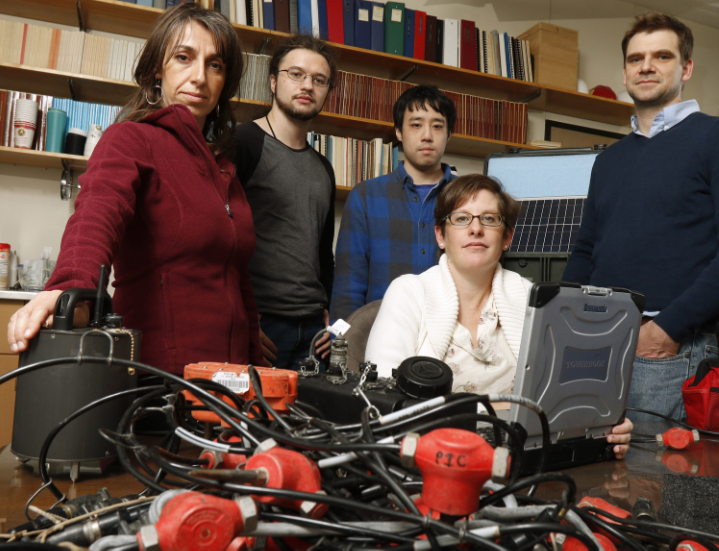Earthquakes shake North Texas
Nathan Hunsinger/The Dallas Morning News/TNS
From left, Maria Beatrice Magnani, associate professor of geophysics; Harrison Oldham, grad student; Kevin Kwong, grad student; Heather DeShon, associate professor; and Matt Hornbach, associate professor, pose for a portrait with their seismic equipment used to test the North Texas area for seismic activity at their lab at SMU in Dallas
May 7, 2015
Texas is known for its absurd unpredictability, with snow in March, extreme heat, and the occasional tornado accompanied by raging thunder storms. And now, added to that list, are earthquakes.
The North Texas risk for a damaging earthquake has more than tripled since the very first quake in 2008 due to man-made activity.
“All indications are that earthquake rates have increased significantly as a result of man-made activity,” chief of the U.S. Geological Survey’s National Seismic Hazard Project Mark Petersen said in the Dallas News.
Even though the DFW area’s risk is on the same level as some parts of California and Oklahoma, the risk is relatively low; about a one in 2500 chance.
“The United States Geological Survey publishes a seismic risk map for Texas which indicates that the North Texas region is at moderately low risk for earthquakes,” Independent Studies coordinator and geology enthusiast Pam Brooks said. “This is especially true when comparing the North Texas region with the west coast of California along the San Andreas Fault Zone where the seismic risk for earthquakes is extremely high. However, it is certainly noteworthy that news of multiple earthquakes around Azle, Cleburne, Farmers Branch, and Irving has Texas residents alarmed.”
The regions that have heightened the risk of these North Texas quakes are the DFW International Airport, the Cogdell oil field near Snyder in West Texas; Fashing in South Texas; and Timpson in East Texas.
“Seismologists as Southern Methodist University have been studying the earthquakes in North Texas since 2008 and have recently published their research in the Nature science journal Nature Communications on April 21, 2015,” Brooks said. “The SMU team of researchers determined that high volumes of wastewater injection combined with saltwater, (brine), extraction from natural gas wells is the most probable reason why the North Texas area has experienced more earthquakes in the past seven years than the entire time period from 1950 to 2007. This means that the cause of the earthquakes is anthropogenic (man-made).”
Even though the risk of a damaging earthquake is relatively low, it is advised to be prepared. Websites such as the American Red Cross and FEMA provide tips on what to do in the event of an earthquake.
“I would recommend that if you live in one of these areas that you should educate those near you on actions to take in the event of an earthquake,” Peterson said in the Dallas News.
Despite the increase in earthquakes in the region, most people on campus aren’t too worried.
“I am not concerned with the earthquakes,” freshman Annie Dale said. “We don’t live in an area with very high risk, so it shouldn’t be an issue.”




